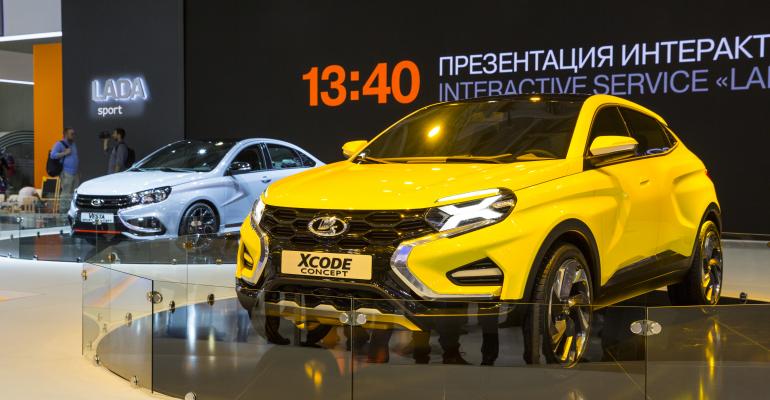VIENNA – Only a handful of automakers are participating in this year’s Moscow auto show because of the country’s persistent economic crisis.
Light-vehicle sales of 109,410 units in July were down 16.5% from prior-year, while deliveries through the year’s first seven months totaled 781,605, down 14.4% from like-2015, according to WardsAuto data.
That puts the industry well behind its best-ever result of 2,935,111 sales in 2012, when the economy was healthier and Western economic sanctions had not taken effect. It also put the industry on pace to fall short of the 2015 total of 1.6 million LVs.
“Unfortunately, we do not see a significant market recovery in the next year,ˮ Nicolas Maure, CEO of AvtoVAZ, Russia’s largest automaker, tells an industry conference in Moscow. “At the best, it will be (an increase of) 10% (in 2017). In the worst case, it will be stable compared with 2016.”
Despite the crisis, AvtoVAZ has decided to participate with the Lada brand at the show, which runs until Sunday.
Measuring 21,528 sq.-ft. (2,000 sq.-m), AvtoVAZ’s stand is the automaker’s largest-ever exhibit at the Moscow auto show.
Lada’s XCode Concept, a 4-wheel-drive CUV, is the automaker’s main attraction this year. Steve Mattin, AvtoVAZ’s British design director, is using the X theme already known as a leading design element of the new Lada Vesta and XRay models for the new concept as well.
A car based on the XCode Concept will begin production after 2018, Maure tells the RIA news agency.
Last year, AvtoVAZ launched production of the Vesta sedan and XRay CUVs. This year, showgoers can see concepts of both models with sporty or CUV accessories.
The Vesta SW Cross Concept also is on display. Already presented at an event last year, the car suggests how the Vesta wagon will look. According to Maure, volume production of the wagon launches in 2017.
The exhibition includes the Vesta CNG Taxi and a stretched version of the Vesta Signature.
Under the name Lada 4x4 Pickup Okhotnik, which means “hunter” in English, AvtoVAZ is exhibiting a double-cab pickup based on its all-wheel-drive SUV with a modernized chassis and equipment for hunters.
Hyundai, No.3 in the Russian market behind Lada and Kia, shows an unusual approach as the entire stand is dedicated just to its newest model, the Creta. Volume production of the compact CUV launched in early August at Hyundai’s plant in St. Petersburg. Exports to other Commonwealth of Independent States countries start shortly, and plans also call for sales to Middle Eastern markets.
Ravon, the new brand introduced in Russia last year for cars manufactured by General Motors in Uzbekistan and previously sold with Chevrolet or Daewoo badges, is presented in Moscow for the first time. The Russian import subsidiary is just launching sales of the Ravon Nexia R3, an Uzbek-made version of the previous-generation Chevrolet Aveo.
Ravon also shows the R4, formerly known as the Chevrolet Cobalt, which will be added later this year.
Chinese manufacturers Geely, Changan, FAW and Dongfeng also introduce cars in Moscow.
Geely, which sells cars assembled in Russia and Belarus, displays its Emgrand GT flagship sedan and NL-3 4WD CUV.
Jumping Aboard the Driverless Minibus
Changan’s exhibition includes the CS35 CUV, which until now was sourced as a completely built-up import from China but will be assembled starting in September at a plant near Lipetsk operated by Russian distributor Irito.
FAW shows its FAW Besturn X80 and D60 CUVs. The automaker is negotiating with Avtotor, a Russian-based assembler working under contracts with BMW, Hyundai and Kia, about the possibility of building both cars locally.
Dongfeng, which sells cars in Russia under the DFM brand, introduces several models, including the A9 large sedan.
Iran Khodro, Iran’s largest automaker, sold cars in Russia in the past and is trying to restart activities in Russia with the help of the Moscow show.
Showgoers at the NAMI stand are getting their first glimpse of the Kamaz Shuttle, Russia’s first driverless minibus.
The vehicle was developed by the Kamaz heavy-truck manufacturer and the NAMI automotive R&D institute. According to NAMI, it can accommodate 12 passengers and has a range of about 120 miles (200 km) before recharging.
Kamaz and NAMI are cooperating with Yandex, a Russian competitor with Google, in the field of autonomous vehicles. Kamaz Shuttle passengers will be able to select destinations with the help of a smartphone app that connects to Yandex’s cloud.
NAMI also shows a 6.6L V-12 capable of developing 857 hp and intended for future limousines developed as part of the Cortege project.





